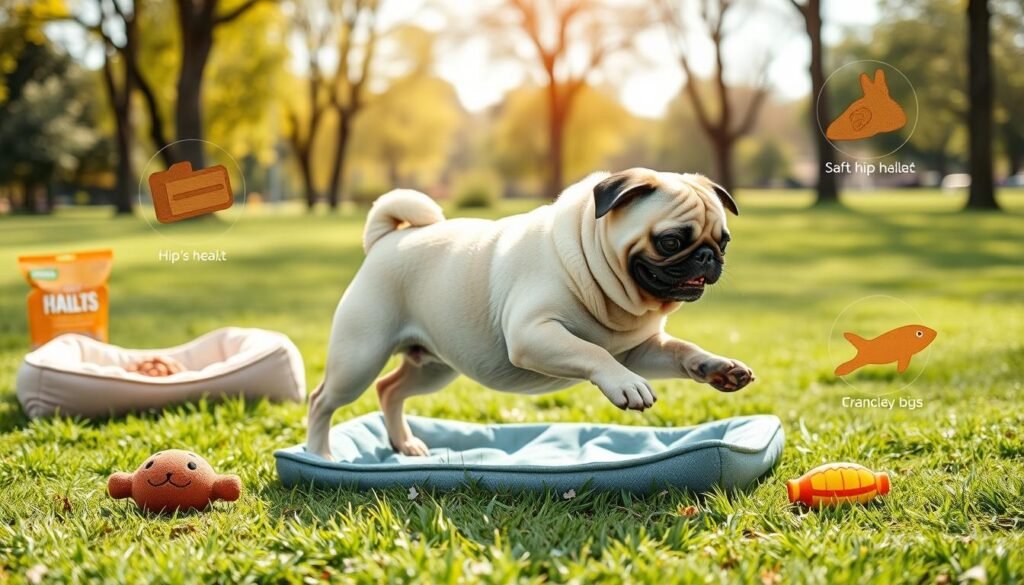How to avoid hip dysplasia in Pugs
About 15% of dogs suffer from hip problems, but Pugs are especially at risk. They are more likely to get hip dysplasia. As a Pug owner, it’s crucial to protect their joints. Knowing the causes, signs, and how to prevent it can help keep your Pug active and happy.
What is Hip Dysplasia in Dogs?
Hip dysplasia is a common problem in dogs. It happens when the hip joint doesn’t fit right. This causes pain, instability, and damage to the joint over time.
Many things can cause hip dysplasia. These include genetics, environment, and diet.
Causes and Symptoms
The main causes of hip dysplasia in dogs are fast growth, injury, and genetics. Signs of hip dysplasia in dogs include limping and a “bunny-hopping” gait. Dogs may also be stiff, not want to jump, and lose muscle in their back legs.
Impact on Quality of Life
Hip dysplasia can really hurt a dog’s life quality. It makes moving hard and painful. This leads to less activity and less fun in daily life.
“Not all dogs can receive a conclusive hip dysplasia diagnosis based on an X-ray.”
In the U.S., two main tests are used to check for hip dysplasia. The Orthopedic Foundation for Animals (OFA) and the PennHIP protocols are these tests. The OFA test needs a dog to be two years old. But, the PennHIP test can start as early as four months.
Genetic Predisposition and Breeding Practices

Hip dysplasia in Pugs is mainly caused by genetics. Up to 50% of Pugs have it because of inherited issues. Responsible breeders use tests like the Orthopedic Foundation for Animals (OFA) and PennHIP to check for hip health. They only breed dogs with healthy hips to lower the risk of hip dysplasia in puppies.
It’s important to not breed dogs with hip dysplasia. This helps prevent the condition from being passed on to future puppies.
Responsible Breeding for Hip Health
Pugs are more likely to get hip dysplasia because of their body shape. Breeders must work hard to improve hip health. They do this by testing for genetics and only using dogs with healthy hips, as certified by OFA and PennHIP.
By focusing on hip health, breeders can lower the risk of genetic factors in hip dysplasia. This ensures Pug puppies have a better chance of avoiding this serious condition.
Good breeding for healthy hips in Pugs also means watching how puppies grow and eat. Too much weight or fast growth can make hip dysplasia worse. So, breeders need to make sure puppies eat right and exercise well.
This way, breeders can help make Pugs healthier overall.
“Responsible breeding is the key to reducing the prevalence of hip dysplasia in Pugs. Breeders who prioritize OFA and PennHIP certifications are taking an important step towards healthier hips for future generations.”
How to Avoid Hip Dysplasia in Pugs

As a Pug owner, you want your pet to be healthy and pain-free. Hip dysplasia is a big worry for Pugs, as it can really hurt their quality of life. But, there are steps you can take to keep your Pug’s hips healthy.
- Choose a Responsible Breeder: Pick a Pug puppy from a breeder who checks for hip health. They should only breed dogs with great hip scores. This helps lower the chance of your Pug getting hip dysplasia.
- Maintain an Ideal Weight: Too much weight can hurt your Pug’s hips. Feed them a balanced diet and keep them at a healthy weight.
- Encourage Low-Impact Exercise: Activities like short walks, swimming, and gentle play help strengthen your Pug’s hip muscles. Avoid activities that might hurt their hips.
By following these steps, you can lower the risk of hip dysplasia in your Pug. This way, you can enjoy a long, healthy life together. Remember, keeping your Pug’s joints healthy is all about prevention.
“Genetics is the biggest factor in hip dysplasia, but nutrition, environment, and lifestyle also play a role.”
Proper Nutrition and Weight Management

Keeping a Pug at a healthy weight is key for their hip health. Pug puppies need a diet that helps them grow slowly, not too fast. This helps avoid hip dysplasia, a common problem for Pugs.
As Pugs get older, it’s important to keep them at the right weight. Too much weight can hurt their hip joints and make dysplasia worse.
Ideal Diet for Pug Puppies
The right Pug puppy diet for hip health is all about the right nutrients. Look for puppy food with good proteins, not too much fat, and the right amount of calcium and phosphorus. Omega-3 fatty acids, like those in salmon, can also help with joint health.
Maintaining a Healthy Weight
Keeping a healthy weight for Pugs is vital to prevent hip dysplasia. A balanced diet with the right portions is essential. Stay away from processed foods with bad preservatives, as they can make joint problems worse.
Regular exercise and watching your Pug’s weight closely are important. This helps them stay healthy and in the right weight range for their whole life.
Exercise and Activity Levels
For Pugs with hip dysplasia, picking the right exercise is key. Regular activity is good, but high-impact exercises can hurt their joints. Look for low-impact activities that strengthen the muscles around the hips without too much stress.
Low-Impact Exercise for Pugs
Good options for Pugs with hip dysplasia include:
- Leashed walks at a moderate pace
- Swimming or hydrotherapy sessions
- Gentle, controlled playtime on soft, cushioned surfaces
These exercises keep your Pug fit and strong without harming their hips. Stay away from jumping, running, or sudden turns, as they can make hip problems worse.
Work with your vet to create an exercise plan that fits your Pug’s needs. By choosing low-impact activities for Pugs, you can prevent more hip dysplasia and improve their life quality.
“Appropriate exercise is key to managing hip dysplasia in Pugs. Focus on low-impact activities that strengthen the muscles without placing excessive stress on the joints.”
Supplements for Joint Support
If your Pug is at risk of or experiencing hip dysplasia, supplements can help. Glucosamine, chondroitin, and omega-3 fatty acids are key. They help keep cartilage healthy, reduce inflammation, and improve mobility. Always talk to your vet to find the right supplements for your Pug.
The pet-supplement market is growing fast, at 7.5% by 2026. More vets are suggesting supplements for joint health. Studies show these supplements can really help dogs.
- Omega-3 fatty acids from fish oil are well-supported for joint health.
- Avocado and soybean unsaponifiables (ASUs) help reduce joint inflammation in dogs.
- Green-lipped mussels support cartilage and reduce inflammation in dogs with arthritis.
- Undenatured type II collagen (UC II) helps prevent cartilage damage, especially when used alone.
Choosing high-quality supplements is key for your Pug’s joint health. Look for products from trusted brands. The National Animal Supplement Council (NASC) checks its members to ensure products are safe and effective. Recommended supplements include Nutramax Dasuquin Soft Chews, Native Pet Relief, and MOVOFLEX Joint Support Soft Chews.
“Supplements can be a valuable addition to your Pug’s care plan, but it’s crucial to consult your veterinarian to ensure the right dosage and formulation for your individual pet.”
Remember, supplements are just part of the solution. A balanced diet and exercise are also essential. Together, these can keep your Pug’s joints healthy and improve their life.
Early Screening and Diagnosis
Dealing with hip dysplasia in Pugs begins with catching it early. Regular vet visits and special tests like radiographs or the PennHIP evaluation can spot it before symptoms show. This early action helps manage the condition, including controlling weight and adjusting exercise.
Spotting hip dysplasia early greatly improves a Pug’s future. Studies show that identifying joint looseness can pinpoint issues in puppies as young as 10 weeks. This early detection opens the door for treatments like Juvenile Pubic Symphysiodesis (JPS) surgery.
For more serious cases, diagnosing hip dysplasia in Pugs might mean surgery. Options like Total Hip Replacement (THR) or Double/Triple Pelvic Osteotomy (DPO/TPO) depend on the dog’s age and how bad the condition is. These surgeries can make your Pug pain-free and mobile again, boosting their happiness.
It’s key to be proactive in screening for hip dysplasia in Pugs. This way, you can catch it early and start the right treatment. By being alert and teaming up with your vet, you can keep your Pug’s joints healthy and their life full of joy.
Managing Hip Dysplasia in Pugs
If your Pug has hip dysplasia, a detailed plan is key to their comfort and movement. This plan might include medical treatments, lifestyle changes, and sometimes surgery.
Medicines like NSAIDs and supplements with glucosamine and chondroitin can ease pain and help repair cartilage. Physical therapy, like hydrotherapy and gentle exercises, keeps muscles strong and joints flexible. Your vet might suggest surgery like total hip replacement or pelvic osteotomy for serious cases.
Keeping your Pug at a healthy weight is very important. Extra weight puts more stress on their hips. A comfy, orthopedic dog bed and soft surfaces like grass or sand can also help. Some Pugs find relief in acupuncture and chiropractic massages too.

